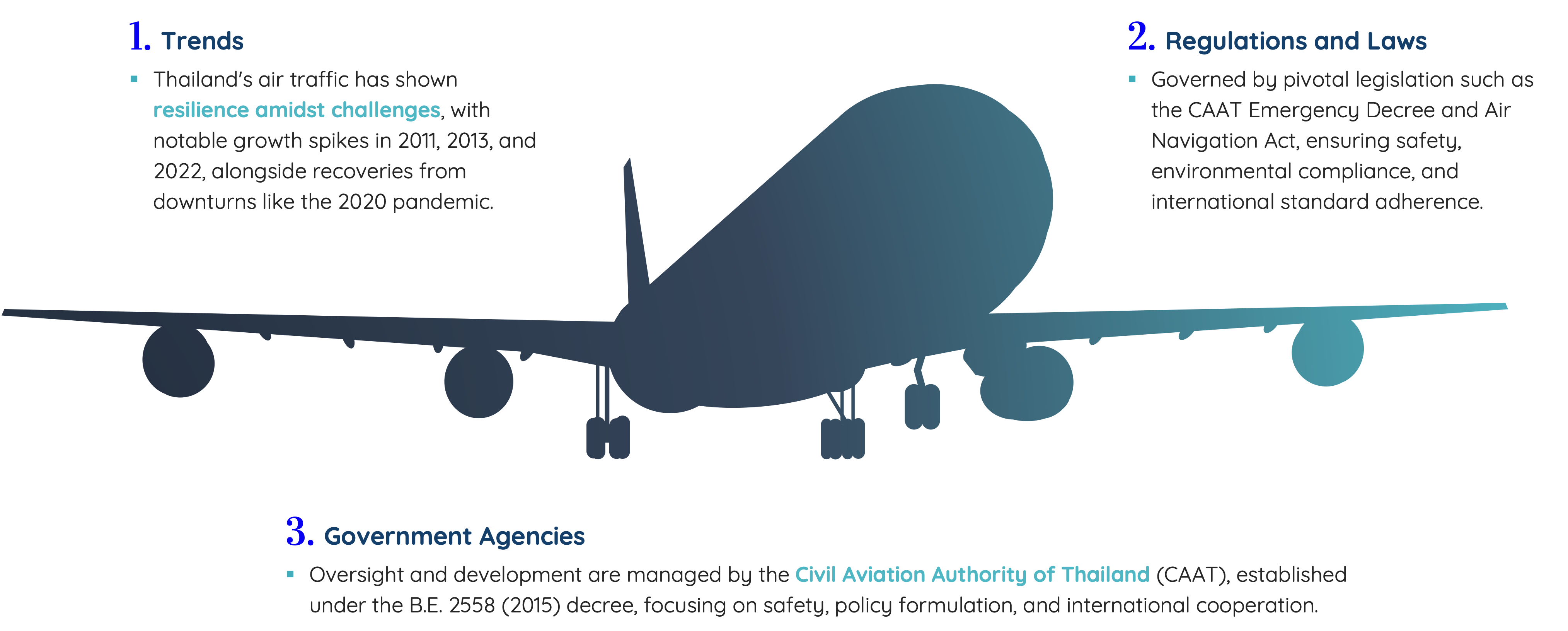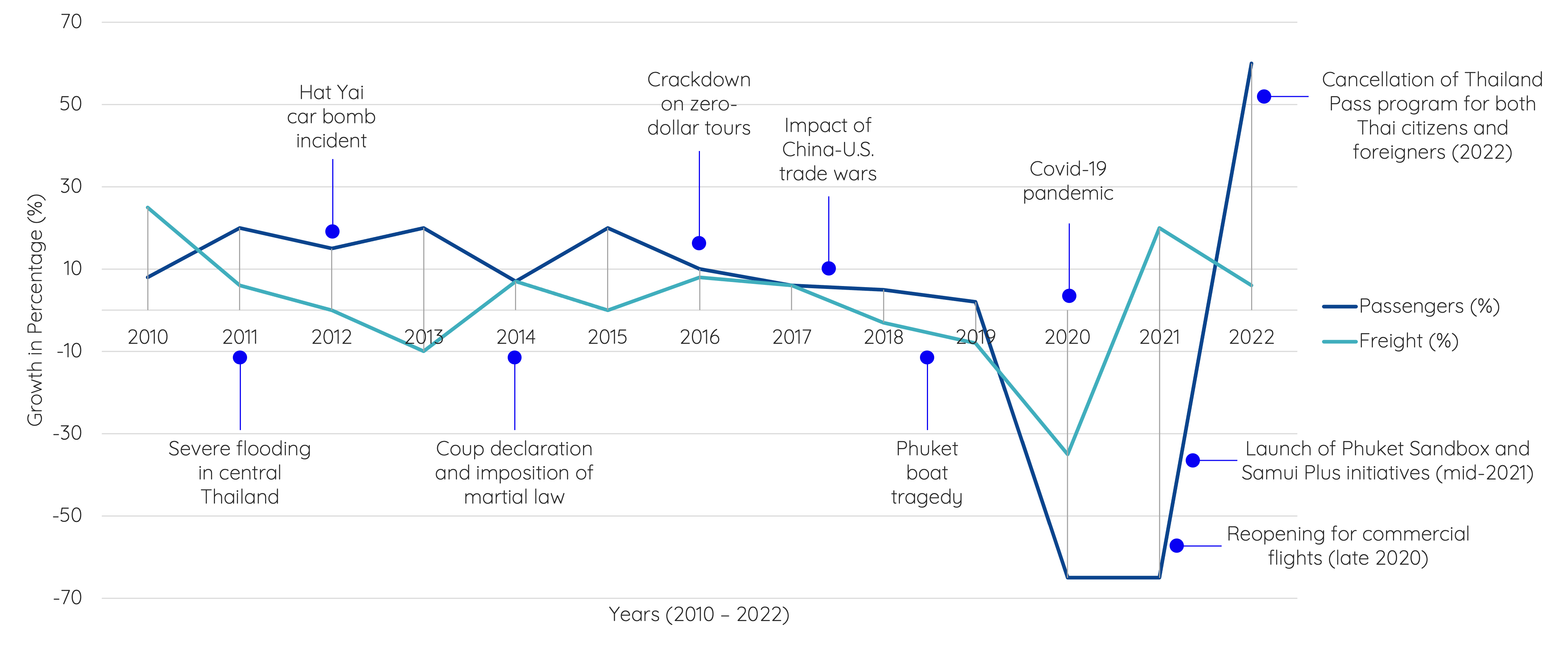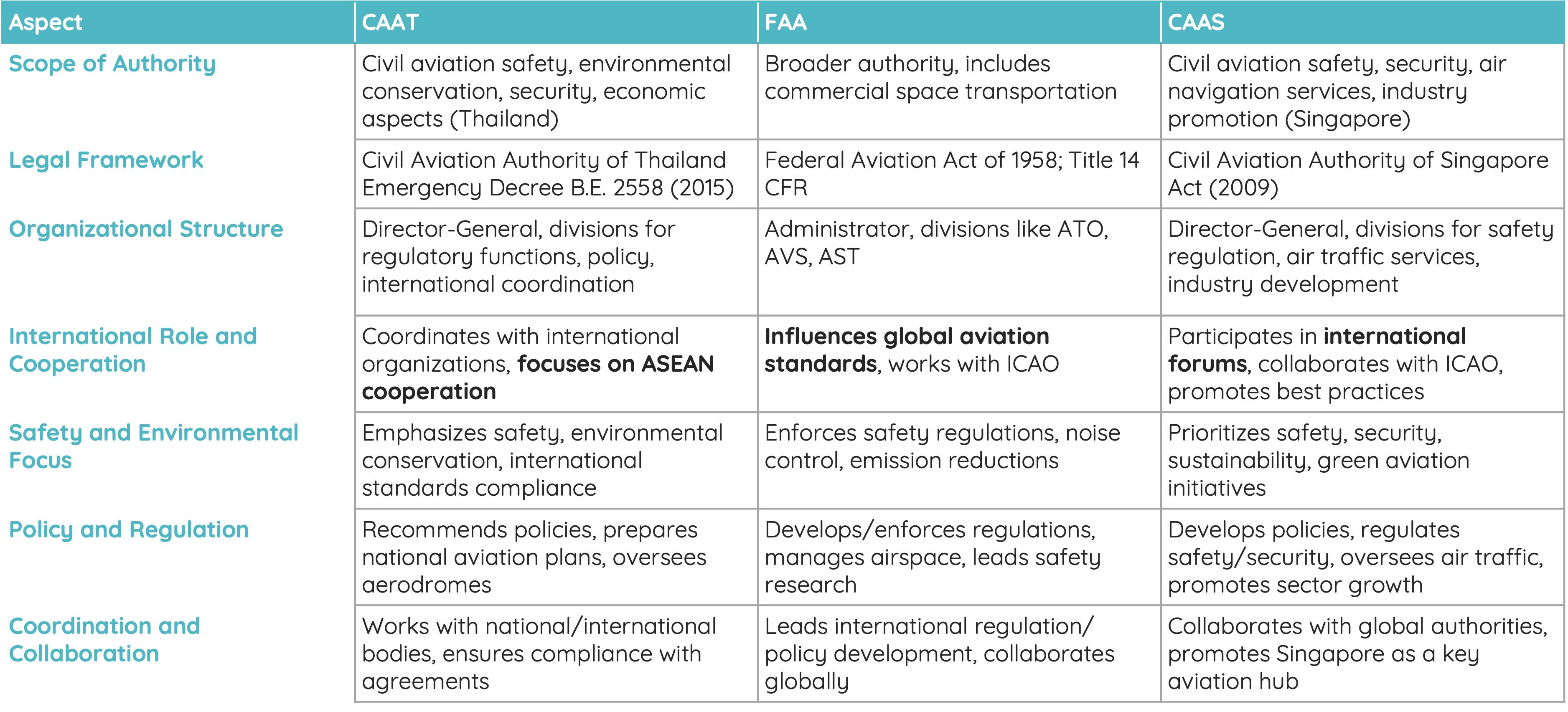The aviation and aerospace industry in Thailand is a dynamic sector that plays a crucial role in the country’s economic development and international connectivity. This overview examines the primary regulations and laws governing the industry, the roles and responsibilities of government agencies, international agreements to which Thailand is a party, recent developments, and a comparative analysis with other countries. The insights provided here will offer a comprehensive understanding of the legal and regulatory landscape shaping Thailand’s aviation and aerospace activities.

Figure 1. Thailand’s Aviation Landscape Trends, Regulations, and Agencies.
Regulations and Laws
1. Civil Aviation Authority of Thailand Emergency Decree B.E. 2558 (2015)
The Civil Aviation Authority of Thailand (CAAT) was established under this decree to regulate civil aviation activities in Thailand. CAAT is a state agency, not a government agency or state enterprise, and operates with the status of a juristic person. Its primary objectives include ensuring safety, environmental conservation, security, air transport facilitation, and compliance with international standards.
2. Air Navigation Act B.E. 2497 (1954), as amended
This Act regulates civil aviation in Thailand to fulfill obligations under the Convention on International Civil Aviation (Chicago Convention). Key provisions include:
✓ Powers of the Minister of Transport and the CAAT Director
✓ Civil Aviation Board’s duties
✓ Aircraft registration and airworthiness control
✓ Personnel licensing
✓ Aerodrome and air navigation facilities
✓ Passenger service charges
✓ Aircraft accident investigation
3. Ministerial Regulation on Criteria and Conditions to Apply for Air Operator License B.E. 2559 (2016)
This regulation outlines the criteria for issuing Air Operator Licenses, strengthening oversight and monitoring mechanisms.
4. International Air Carriage Act B.E. 2558 (2015)
This Act governs international air carriage for reward and gratuitous carriage by aircraft. It aims to ensure fair compensation for passengers and promotes the effective functioning of international air transport.
5. Act on Certain Offenses Against Air Navigation B.E. 2558 (2015)
This Act addresses offenses committed on board aircraft, including powers and duties of aircraft commanders and in-flight security officers.
6. Act on Treatments Against Aircrafts Committing Wrongful Acts B.E. 2553 (2010)
This Act coordinates with military officers to address aircraft committing wrongful acts that threaten public safety or national security.
7. Declaration of the Revolutionary Council No. 58 B.E. 2515 (1972)
This declaration requires individuals to obtain permission or a concession from the Minister of Transport to operate air navigation services in Thailand.
8. The Customs Act, B.E. 2496 (1953)
This Act governs the importation and exportation of goods, customs control, and the management and designation of ports.
Government Agencies
1. Civil Aviation Authority of Thailand (CAAT)
CAAT was established under the Civil Aviation Authority of Thailand Emergency Decree B.E. 2558 (2015) to oversee civil aviation activities in Thailand. Its objectives include:
✓ Ensuring safety, environmental conservation, security, and compliance with international standards
✓ Implementing the law on certain offences against air navigation
✓ Promoting and developing the air transport system network
✓ Acting as the center for providing services and disseminating information on civil aviation
CAAT’s duties include recommending policies, preparing national aviation plans, regulating civil aviation, and coordinating with international organizations.
2. Civil Aviation Authority of Thailand Commission
The CAAT Commission, chaired by the Permanent Secretary for Transport, oversees CAAT’s operations. Its responsibilities include setting policies, approving plans and projects, and issuing regulations related to CAAT’s functions.
3. Director of the Civil Aviation Authority of Thailand
The CAAT Director manages CAAT’s affairs, ensuring compliance with laws, regulations, and international standards. The Director reports to the CAAT Commission and oversees the implementation of national aviation plans.
International Agreements
1. Montreal Convention
Thailand ratified the Montreal Convention on August 4, 2017. The convention aims to ensure fair compensation for passengers in cases of injury or death and for damage to baggage and cargo during international air travel. It promotes the smooth functioning of international air transport.
2. Other Agreements
Thailand is a party to various international agreements and treaties related to aviation safety standards, air transport, and aircraft maintenance. These agreements help Thailand align its aviation practices with global standards and enhance its international aviation relationships.
Recent Developments
1. COVID-19 Recovery
The aviation industry in Thailand is expected to return to pre-pandemic levels by 2025, driven by global economic recovery and increased consumer spending on travel and tourism. The Thai economy is forecast to grow annually by 3.0-4.0% over the next three years, with the tourism sector playing a significant role.
2. Government Initiatives
The Thai government is promoting travel to Thailand for high-potential groups, including long-term residents, the elderly, medical tourists, and LGBTQ+ individuals. Visa-free travel is being offered to higher spending tourists, including Chinese and Indian arrivals.
3. Airport Upgrades
Thai officials have plans to upgrade airports to handle increased air traffic and passenger numbers. Suvarnabhumi Airport’s Satellite 1 building will begin operations at the end of 2023, increasing the airport’s annual capacity from 45 million to 60 million passengers. Improvements to existing airports and the construction of new departure lounges are also planned.

Figure 2. Variations in Thailand’s Air Traffic Growth Rates.
Comparative Analysis: CAAT vs. FAA and CAAS
1. Federal Aviation Administration (FAA)
✓ Establishment: Created by the Federal Aviation Act of 1958
✓ Status: Agency of the U.S. Department of Transportation
✓ Roles and Responsibilities: Regulates all aspects of civil aviation in the U.S., including aircraft certification, airmen certification, air traffic control, safety regulations, and commercial space transportation
2. Civil Aviation Authority of Singapore (CAAS)
✓ Establishment: Established under the Civil Aviation Authority of Singapore Act on 1 September 1984, reconstituted in 2009
✓ Status: Statutory board under the Ministry of Transport, Singapore
✓ Roles and Responsibilities: Regulates and oversees civil aviation safety and security, provides air navigation services, and promotes the aviation industry in Singapore
Differences
✓ Scope of Authority:
⦾ CAAT: Focuses on civil aviation safety, environmental conservation, security, and economic aspects within Thailand.
⦾ FAA: Broader authority, including commercial space transportation.
⦾ CAAS: Focuses on civil aviation safety, security, air navigation services, and the promotion of the aviation industry in Singapore.
✓ Legal Framework:
⦾ CAAT: Governed by the Civil Aviation Authority of Thailand Emergency Decree B.E. 2558 (2015).
⦾ FAA: Governed by the Federal Aviation Act of 1958 and regulations codified in Title 14 of the Code of Federal Regulations (CFR).
⦾ CAAS: Governed by the Civil Aviation Authority of Singapore Act (2009).
✓ Organizational Structure:
⦾ CAAT: Managed by a Director-General, with divisions focused on regulatory functions, policy recommendations, and international coordination.
⦾ FAA: Led by an Administrator, with specialized divisions like the Air Traffic Organization (ATO), Aviation Safety (AVS), and the Office of Commercial Space Transportation (AST).
⦾ CAAS: Managed by a Director-General, with divisions responsible for safety regulation, air traffic services, industry development, and infrastructure management.
✓ International Role and Cooperation:
⦾ CAAT: Coordinates with international organizations to meet obligations under international conventions and agreements. Focuses on ASEAN regional cooperation.
⦾ FAA: Influences international aviation standards and policies, working closely with global organizations such as ICAO.
⦾ CAAS: Actively participates in international aviation forums and collaborates with ICAO and other global aviation authorities, focusing on international best practices and agreements.
✓ Safety and Environmental Focus:
⦾ CAAT: Emphasizes the development of civil aviation with respect to safety, environmental conservation, and compliance with international standards.
⦾ FAA: Enforces stringent safety regulations and environmental standards, including noise control and emission reductions.
⦾ CAAS: Prioritizes aviation safety, security, and environmental sustainability, implementing stringent regulations and promoting green aviation initiatives.
✓ Policy and Regulation:
⦾ CAAT: Recommends policies to the Civil Aviation Board and the Minister, prepares national aviation plans, and oversees aerodrome operations.
⦾ FAA: Develops and enforces aviation regulations, manages national airspace, and leads aviation safety research.
⦾ CAAS: Develops aviation policies, regulates aviation safety and security, oversees air traffic management, and promotes the aviation sector’s growth.
✓ Coordination and Collaboration:
⦾ CAAT: Works with national and international bodies on civil aviation matters, ensuring compliance with international agreements.
⦾ FAA: Plays a leading role in international aviation regulation and policy development, collaborating extensively with global aviation authorities.
⦾ CAAS: Collaborates with international aviation authorities and organizations, promoting Singapore as a key aviation hub and ensuring adherence to global standards.

Figure 3. Comparative Analysis: CAAT vs. FAA and CAAS.
Dispute Resolution and Applicability of Foreign Law in Thailand Aircraft Lease Agreements
In Thailand, navigating the legal landscape of aircraft lease agreements involves critical considerations regarding dispute resolution and the applicability of foreign law. When parties engage in such agreements, they frequently confront issues concerning how disputes will be resolved and whether foreign laws can govern their contracts. Thai law permits parties to opt for foreign jurisdictions and laws to govern their agreements, provided that the chosen foreign laws do not contradict Thailand’s public order or moral standards.
Arbitration emerges as a favored method for resolving disputes in aircraft lease agreements due to its impartiality and enforceability, particularly under the New York Convention, which Thailand has ratified. This convention facilitates the recognition and enforcement of arbitral awards across international borders, enhancing legal certainty and predictability for parties involved in cross-border transactions. Understanding the nuances of selecting foreign laws and arbitration clauses is crucial for ensuring the enforceability of agreements and the efficient resolution of disputes, aligning with Thailand’s commitment to international legal standards and cooperation in aviation matters.
Key Takeaways
Thailand’s aviation and aerospace sector is governed by robust regulations, including the Civil Aviation Authority of Thailand Emergency Decree and the Air Navigation Act. These laws ensure safety, environmental conservation, and compliance with international standards. The Civil Aviation Authority of Thailand (CAAT) oversees these regulations, playing a pivotal role in promoting civil aviation while upholding legal requirements and international agreements such as the Montreal Convention. Recent developments highlight post-COVID-19 recovery efforts, including projected economic growth and government initiatives to attract tourists, supported by infrastructure upgrades at key airports like Suvarnabhumi Airport. Compared to counterparts like the FAA and CAAS, CAAT focuses on regional aviation safety and environmental sustainability within Thailand, aligning with ASEAN and global standards. Legal considerations, such as the option for parties to choose foreign law and arbitration for dispute resolution in aircraft lease agreements, underscore Thailand’s commitment to international cooperation and adherence to conventions like the New York Convention for enforceability.
